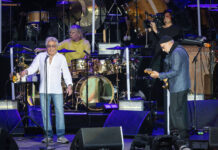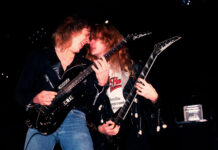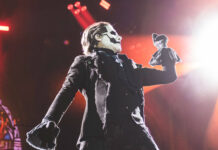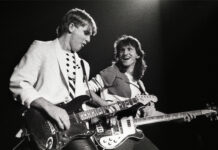
Old Blood Noise Endeavors Dark Star Stereo review – taking immersive reverb to the next level
£299/$299, oldbloodnoise.com
If you’re compiling a list of the wrongest things you’ve seen on the internet this year, the Old Blood Noise Endeavors website probably isn’t going to make the top five. But still… are they serious when they describe the Dark Star Stereo as a “lo-fi” reverb pedal? I put it to you, Old Blood, that if this is lo-fi then Kung Fu Panda 4 is a gritty arthouse flick.
In fact, this relatively compact soundscaping tool can be just as hi-fi as you want it to be – but with the option of introducing some distortion to the reverb for extra density and power. Add two separate pitch-shift circuits, an EQ filter, a multi-purpose second footswitch and three slots for saving presets, and you’ve got quite the ambient toolbox at your feet.
Image: Press
What is the OBNE Dark Star Stereo?
This is not a multi-mode all-rounder like the Strymon BlueSky or Walrus Audio R1. It’s the kind of dreamscape-creating reverb that evokes words like ‘epic’, ‘lush’ and, if you’re not careful, ‘celestial’. So there’s no faux-spring mode: it’s all about starting out big and washy, then seeing how much bigger and washier it can go before you get carried away and forget how to play the guitar.
As the name suggests, it’s stereo, though you need to press a couple of buttons to change it from the default mono operation. It’s also true bypass and analogue dry-through, so nothing untoward will happen to your original signal while all that spaciness is being added on top.
Actually though, what is the name of this pedal? Everyone seems to be calling it the Dark Star Stereo, but all you get from the enclosure, packaging and user manual (not to mention that blimmin’ website, in the same sentence as “lo-fi”) is Dark Star – and that was the name of the old mono version. Perhaps Old Blood wants to pretend the original pedal never existed? Bit weird, that…
Image: Press
Is the OBNE Dark Star Stereo easy to use?
Ten knobs is a lot, but somehow it doesn’t feel like it here. That’s partly because you can switch the pedal on with everything set to halfway and it sounds magical already; but it’s also partly because those knobs are easily divided into three simple groups.
The four along the top are all centre-notched, so by default they’re effectively off: ‘filter’ makes things darker to the left and brighter to the right; the two pitch controls shift down to the left and up to the right, as far as two octaves; then ‘crush’ adds sample-rate reduction glitchiness to the left and smooth distortion to the right.
The second row is all about the hugeness: ‘lag’ controls the length of the pre-delay before the reverb kicks in; ‘multiply’ sends the effect to feed back into itself for extra richness; and ‘decay’ sets the length, from something like a large tiled bathroom to a space slightly wider than the universe.
Then you’ve got little knobs for volume, wet/dry mix and stereo spread, plus a button for toggling through the three presets and manual mode. That just leaves the ‘aux’ footswitch, which can be assigned to any one of three automated moves: near-infinite sustain, an octave-up pitch sweep, or shutting down the filter. To select that function, you simply hold down the switch and move the appropriate knob; the pedal will remember different options for different presets.
Image: Press
What does the OBNE Dark Star Stereo sound like?
The good news is, it sounds quiet, with no intrusive background noise and no footswitch pops. And the bad news? Nope, sorry, haven’t got any – because this thing is fantastic. It’s as impressively gigantic as a hot air balloon in the shape of a polar bear, and every bit as adorable.
To be fair to Old Blood, there is something going on here that could almost be described as lo-fi: the effect has a flutteriness that puts it somewhere between pure reverb and a fast multi-tap delay. It’s not too obvious, but it does make everything that comes out of the pedal that little bit more colourful and interesting.
Between the filter, lag and mix controls, it’s easy to get the basic reverb to sit just where you want it; and then it’s time to break out the toys… starting with a second amp and a Y-cable, because everything this unit does so well in mono sounds even better – like, way better – in stereo.
The pitch controls are stepped in semitones, so you don’t need to worry about tuning accuracy, but you can create a lovely bit of modulation by setting them just a smidge either side of the middle notch. Or you might prefer to keep things simple with a straight octave-up effect; the only downside here is that there’s no obvious way to control the relative level of any pitch-shifted output for more subtle shimmer effects. (Here’s the non-obvious way: if you set up the pedal for stereo but only use one amp, the spread control can send some of the ‘pitch 2’ output to a non-existent second channel.)
Image: Press
Where Old Blood has really crushed it, though – quite literally – is with the distortion. The low-resolution effects to the left of the dial are quirky and kooky, but whack it over the other way for the absolute best sound on offer here: a mighty blast of overdriven reverb in full stereo, gathering in gritty intensity as it cascades towards oblivion. It’s awesome in the original, pre-Californian sense of the word.
But now let’s come back down to earth with a slight bump by talking about the second footswitch – which isn’t very good. The most obvious use for it is to push the reverb into near-infinite sustain, and this works well… unless you want to keep playing over the top, because anything you add is locked out of the reverb circuit and will therefore be bone-dry. This is an understandable design decision, but it almost never sounds good unless you have another reverb on your board.
The rapid pitch-bending and filter-squishing options, while both entertaining enough, are limited in musical usefulness – but here’s a nice twist that involves two simple steps. Firstly, plug in an expression pedal to do everything the footswitch can do but a hundred times better; and secondly, set that switch to toggle through the presets instead. Hey presto: instant hands-free access to all the biggest, dreamiest reverb tones in the cosmos.
Should I buy the OBNE Dark Star Stereo?
For some people, the last word in reverb will be something large and expensive – specifically the Meris MercuryX or Strymon BigSky MX. But if you just want a small, intuitive pedal with the ability to generate massive clouds of thunderous reverberation in a range of shapes and colours, there really is no need to look beyond the Dark Star Stereo.
OBNE Dark Star Stereo alternatives
Old Blood’s most obvious rival here is the Walrus Audio Slöer (£319), but if you’re feeling bold you might also look at the Gamechanger Audio Auto Reverb (£299). The Caroline Météore (£239) goes big on the lo-fi thing, but that one’s mono only.
The post Old Blood Noise Endeavors Dark Star Stereo review – taking immersive reverb to the next level appeared first on Guitar.com | All Things Guitar.
Source: www.guitar-bass.net












